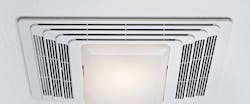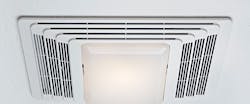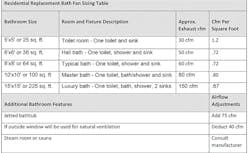Are you happy with your bathroom exhaust fans at home? Odds are unless you've upgraded it since building your home, it's noisy, the grille is ugly, and it moves very little airflow. Most of your customers suffer from these same problems. Let's take a look at replacement exhaust fans, how to size them, and why you should consider offering this well-received upgrade to your customers.
The Typical Exhaust Fan
In the past, bathroom exhaust fans installed in many residential new construction homes often scrape the bottom of the barrel. The typical exhaust fan needing replacement today in a standard home may have cost less than $10 when new. Many were not attached to an exhaust duct. From data National Comfort Institute (NCI) collected in 2009, the typical bathroom exhaust fan moves less than 13 cfm or about 20% of what it should.
I was surprised to find many online handyman services refer bathroom exhaust fan replacements to electricians. Well, let's take that business back where it belongs in the HVAC industry. We can offer and install correctly sized, quiet bathroom fan systems with up-to-date fan and occupancy controls.
What's Your Budget?
The budget to swap out an existing small bath fan may not be a worthwhile standalone project because it sells for less than $200. However, adding exhaust fan upgrades to an equipment replacement job adds real value and benefits to the project. On the other hand, replacing the exhaust fan in a large master bath where a new water-jet tub was just installed may exceed $1000 or more and can be a valuable and profitable job.
When discussing bath fan options with customers, it's important to assess their wants and needs accurately and consider airflow to each bathroom before making your recommendations.
Variables to consider when discussing bath fan upgrades and budgets with your customers should include:
Exhaust fan airflow capacity – Size the fan to handle the ventilation needs of the room. You determine fan airflow by the room size number of fixtures and the fan's controls.
Ducting – Exhaust air must be ducted outdoors. Existing exhaust ducts may only be three-inch aluminum flex. Its size may be the reason airflow is so restricted. Usually, when you replace a new fan, you also replace the duct. Should it be flex, hard pipe, or rectangular duct?
Timers and speed controls – Some fan replacements will reuse the existing light switch. Some customers may want a multi-position speed control. The Cadillac version may be an automatic multi-speed control with a shut-off timer with a continuous low-flow ventilation setting to ventilate the home.
Your customers will look to you for guidance with each decision about these options above. So, it's your job to know and provide the answers they'll need to make the right decisions.
Consider several pre-packaged bath fan options with flat-rate pricing. This tool will make it easy for your team to size and price replacement bath fans and simple for your customers to buy.
This really happened…
Most important is what your customer wants and how valuable the desired outcome is to them.
When completing a system upgrade by balancing a home with a customer named Janet, I routinely measured the master bath fan airflow. The hood revealed its airflow was near 40 cfm. She was a beautiful woman who always looked perfect. When she heard 40 "buckets of air per minute," her immediate response was to ask if I could increase airflow to 500. I wasn't sure why, but she was very motivated to increase airflow.
Back at the shop, I priced the new fan system. I stopped by the house fairly early the next morning, and a woman came to the door. I asked to speak to Janet. She exclaimed, "Oh Rob, it's me without makeup!" I immediately understood why removing humidity and having a clear mirror in the bathroom was important. The next day we installed a powerful bath exhaust fan with a four-speed controller. From that day to now, she looks marvelous. And I know why.
How much airflow?
Most ventilation codes, standards, and manufacturer recommendations are pretty vague or overly generalized when recommending bath fan airflow requirements. Many quote a default of 50 cfm for a bathroom and call it good. Of course, you should check with local code officials for a barometer reading of what their current requirements may be.
When discussing bath fan options with customers, it's important to assess their wants and needs accurately and consider airflow to each bathroom before making your recommendations.
An inquiry during a training class by Mike Meredith of Munn's Sales & Service in Florida gave birth to a residential bath fan sizing table for field use. Mike needed a quick reference table to size fans for replacement opportunities he finds in the field. It has been a worthwhile project, and we decided to share it with you.
Of course, there are assumptions made. Some bathroom airflow conditions may fall outside of assumed parameters and perhaps local code requirements, so please check first. We assumed a ceiling height of eight feet, a single-speed fan, and an on-off switch. Another assumption is that the bigger the room (square feet), the more fixtures the bath may contain.
The table includes the typical number of fixtures and provides added exhaust airflow values at the bottom. It also contains other selection suggestions. We looked at various codes, standards, and manufacturer recommendations in the creation of this table. Hopefully, it will serve as a quick reference to help you choose the right fan size to recommend in the field.
Other Considerations and Rules of Thumb
Because each bathroom may contain a variety of features and fixtures, here are conditions you may want to think about when sizing replacement bath fans and accessories.
- Consider adding transfer air from the main body of the home when bath fan airflow exceeds 150 cfm
- Consider adding makeup air into the home when total exhaust in the home exceeds 300 cfm
- Consider recommending a multi-speed control with a shut-off timer
- Increase exhaust airflow 3% for every foot of ceiling height greater than 8 feet
- If separate rooms are in a bath suite, size a different fan for each room
- The average exhaust cfm per square foot of floor area in this table is about .80
- Some current codes require an ASHRAE 62.2 compliant programmable speed controller with a built-in low-flow constant operation ventilation setting. Always check with local code officials for current compliance requirements.
This table is a field reference guide only.
Remember, selecting fan size is one design element. Exhaust duct sizing, fan-rated static pressure, fan sound levels, grille appearance, humidity sensors, and room heating elements are additional considerations and options you may offer your customers.
Finally, design, installation conditions, and skill are performance elements that cannot assume delivered airflow. Always include final testing and verification of fan airflow in your offering to your customers.
Consider posing this question when appropriate while speaking with your customers: Are you happy with your bathroom exhaust fans?
Rob "Doc" Falke serves the industry as president of National Comfort Institute, Inc., an HVAC-based training company and membership organization. If you're an HVAC professional interested in a free Residential Replacement Bath Fan Sizing Table, contact Doc at ncilink.com/ContactMe or call him at 800-633-7058. Go to NCI's website at nationalcomfortinstitute.com for free information, articles, downloads, and current training opportunities
About the Author
Rob 'Doc' Falke
President
Rob “Doc” Falke serves the industry as president of National Comfort Institute an HVAC-based training company and membership organization. If you're an HVAC contractor or technician interested in a building pressure measurement procedure, contact Doc at [email protected] or call him at 800-633-7058. Go to NCI’s website at NationalComfortInstitute.com for free information, articles and downloads.


